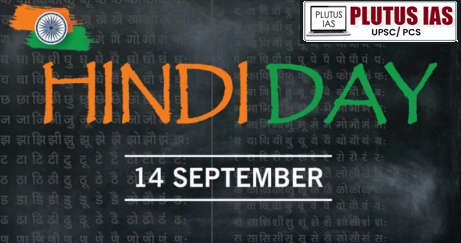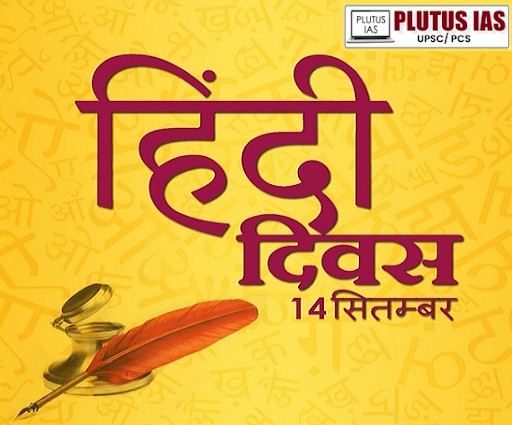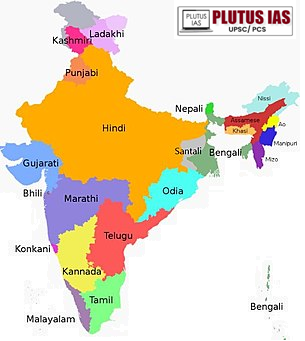14 Sep The National Hindi Diwas
This article covers “Daily Current Affairs” and topic details of the National Hindi Diwas.
Syllabus mapping:
GS-1- Indian Society: The unity and diversity of India.
For Prelims:
What is the official language and its constitutional provisions, difference between the official language and the national language? Schedule 8 facts and languages.
For Mains:
The evolution of Hindi official language of the union? What are the constitutional provisions for the the official language and government initiatives to promote the official language?
Why in the News?
Hindi Diwas is observed nationwide on 14 of September every year. On this day in 1949, the Constituent Assembly designated Hindi, written in the Devanagari script, as the official language of India. Today, Hindi stands as one of the most widely spoken languages globally and serves as the mother tongue for over 520 million individuals.

The official language vs the national language vs classical Language
| Aspect | Official Language | National Language | Classical Language |
| Definition | A language designated by a country’s constitution or laws for official government functions. | A language that holds special status, representing the identity, culture, and unity of a nation. | A language that has a rich heritage and classical literature, recognized for its ancient historical significance. |
| Purpose | Facilitates communication and documentation in government affairs and legal processes. | Reflects the cultural and historical identity of the nation; may symbolize national heritage. | Preserves and promotes ancient literature, philosophy, and cultural heritage. |
| Usage | Used for administrative purposes, court proceedings, and formal state functions. | Often used in cultural, educational, and social contexts; promoted in media and public life. | Studied for academic and cultural purposes; often used in classical literature, religious texts, and historical studies. |
| Example | Hindi: Official language of India. | India does not have a national language. | Sanskrit: Recognized as a classical language of India with a rich historical and literary tradition. |
Language Statistics from the 2011 Census of IndiaMost Spoken Languages: 1. Hindi: 41% of the population speaks Hindi, making it the most widely spoken language. 2. Bengali: 8.1% of the population speaks Bengali. 3. Telugu: 7% of the population speaks Telugu. 4. Marathi: 7% of the population speaks Marathi. 5. Tamil: 5.9% of the population speaks Tamil. Linguistic Diversity: The 2011 Census recorded a total of 122 major languages and 1599 other languages spoken across the country. Scheduled Languages: The Constitution of India recognizes 22 languages under the Eighth Schedule, which include Hindi, Bengali, Telugu, Marathi, Tamil, Urdu, Gujarati, Malayalam, Kannada, Oriya, Punjabi, Assamese, Maithili, Santali, Nepali, Konkani, Sindhi, Dogri, Manipuri, Bodo, Sanskrit, and Kashmiri.
|
Journey of Hindi as the official language:
The Official Language Committee, chaired by Shri K.M. Munshi and with Shri G.K. Iyengar as a key member, played a pivotal role in recommending Hindi as the official language of India. Their efforts were instrumental in shaping India’s language policy, leading to the formal adoption of Hindi, written in the Devanagari script, on September 14, 1949.

Government of India’s Steps to promote Hindi Language:
Constitutional Position:
Part XVII: Constitution of India (Article 343-351)
Article 343: Designates Hindi in the Devanagari script as the official language of the Republic of India.
Article 344: Provides for the creation of a Commission for the Promotion of the Official Language.
Article 345: Allows states to adopt Hindi or other languages for official purposes.
Article 346: Specifies Hindi as the official language of the Union for communication between the Union and the states.
Article 351: Mandates the promotion of Hindi as the link language and its enrichment by assimilating elements from other languages.
Non-Constitutional Measures
Official Languages Act, 1963: Provides for the use of Hindi and English in official communication and prescribes the procedures for the use of Hindi in the central government.
Hindi Sahitya Sammelan (Recognition) Act, 1956: Established a body to organize literary events, support authors, and promote Hindi literature.
NEP 2020: The NEP 2020, advocates for the three-language formula, and many states promote this formula.
Institutional Mechanism: under the Ministry of Home Affairs, the official language department is responsible for promoting Hindi as the official language.
Scheme and initiatives:
Official Language Policy: Outlines the implementation of Hindi in various government departments and institutions, encouraging its use in administrative functions.
Hindi Pakhwada: An annual observance from September 1st to September 15th aimed at promoting Hindi use in government offices and institutions.
Rajbhasha Gaurav Puraskar: Recognize individuals and organizations for their exemplary contributions to the promotion and use of Hindi in official communications.
Rajbhasha Kirti Puraskar: Honors institutions and individuals who have demonstrated outstanding efforts in integrating Hindi in official and academic spheres.
Central Hindi Training Institute (CHTI): Provides Hindi language courses to improve proficiency among non-Hindi speakers, facilitating better use of Hindi in official settings.
Kantahastha Translation Software: Enhances the accuracy and efficiency of translating Hindi texts through advanced memory-based technology.
Hindi Shabd Sindhu – Version 2: Provide an updated and comprehensive Hindi dictionary to support language learning and usage.
World Hindi Secretariat (WHS): Promotes Hindi internationally and advocates for its recognition as a UN official language.
Use of Hindi in Digital Technology: Increases the accessibility of Hindi through Unicode support and digital platforms.
Role of Hindi as a unifying factor in Indian society:
1. Bridging Linguistic Divides: India is home to hundreds of languages and dialects. Hindi, being one of the most widely spoken languages, serves as a common linguistic medium for people from diverse linguistic backgrounds, facilitating easier communication and interaction.
2. Symbol of National Unity: Hindi, as one of the official languages of India, is often associated with national identity. Its widespread use helps foster a sense of belonging and unity among Indians, creating a shared cultural and linguistic framework.
3. Standardized Education: Hindi is taught in schools across India, making it a common medium of instruction in many regions.
4. Official Communication: Hindi is used extensively in government documents, uniformity helps in streamlining government operations and making information accessible to a broader audience, enhancing administrative efficiency and inclusiveness.
5. National Celebrations: Hindi is often used in national celebrations, festivals, and public events. The use of Hindi in such contexts helps promote a shared cultural experience and strengthens the feeling of unity among citizens.
6. Workplace Communication: In many urban and professional settings, Hindi serves as a common language for communication among people from different regions. This facilitates collaboration and economic activities, contributing to a more integrated society.
7. Online Platforms: The rise of digital media in Hindi allows for the exchange of ideas and information across linguistic boundaries. Social media platforms and digital content in Hindi connect people from various regions, fostering a sense of community and shared experience.
Conclusion
While Hindi can act as a unifying factor, it is also important to respect and celebrate India’s rich linguistic diversity. Balancing the use of Hindi with the preservation and promotion of regional languages ensures that the unity achieved through Hindi does not come at the expense of regional identities and cultural richness.
Download plutus ias current affairs eng med 14th Sep 2024
PRELIMS QUESTION:
Q. Consider the following statements:
Statement I: September 14 is celebrated annually as National Hindi Day.
Statement-II: On September 14, 1949, the Constituent Assembly of India officially adopted Hindi as the National language of the country.
Which one of the following is correct in respect of the above statements?
A. Both Statement I and Statement II are correct and Statement II is the correct explanation for Statement I
B. Both Statement I and Statement II are correct and Statement II is not the correct explanation for Statement I
C. Statement I is correct but Statement II is incorrect
D. Statement I is incorrect but Statement II is correct
Answer: C
MAINS QUESTION:
Indian society is characterized by unity in diversity, with language being a prominent aspect of this diversity. Do you think that, in recent years, Hindi has become more popular not only as the official language but also as a widely spoken dialect across India?
(150 words 10 marks)





No Comments